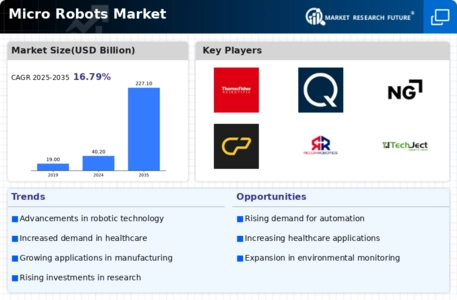Market Share
Micro Robots Market Share Analysis
The market for pharmaceutical micro robots is becoming increasingly dynamic as companies strive to gain a firm foothold in the high-tech medical sector. One key strategy adopted by pharmaceutical firms involves product diversification and innovation, which is specifically focused on creating bespoke micro robots used in medical applications. In an effort to stand out from other players, these corporations seek to attract health care practitioners and researchers who are constantly looking for advanced techniques of targeted drug delivery through using new improved microbots having more efficiency, accuracy or with entirely new features.
Furthermore, cost leadership plays a critical role in the Pharmaceutical Micro Robots Market. To provide affordable technology for micro robots, companies explore suitable materials that can be used for effective production processes so that they can optimize their manufacturing procedures. Companies understand economic feasibility linked with healthcare industry especially towards integration of such developed technologies hence aim at attainable solutions. These companies position themselves as leaders in cost-effective micro robot technologies so that they can win significant market share and address bigger healthcare needs of institutions willing to use these advanced tools.
Additionally, innovation remains a key driver in terms of market share positioning within the Pharmaceutical Micro Robots Market. Consequently, many companies are investing heavily on R&D to come up with totally different kinds of emerging micro robotic platforms that are superior when it comes to precision medicine and targeted interventions. Remaining ahead of other players enables them earn trust among practitioners and researchers due to continuous adoption of better technological tools as well as methods into clinical practice settings. Innovative ways of addressing changing healthcare demands does not only boost medical environment but also affects general development towards pharmacology.
Also worth noting is that strategic collaborations and partnerships have become common within the Pharmaceutical Micro Robots Market nowadays. Therefore, businesses team up with research institutions, health care providers and technology-centered entities among others sought as means of expanding knowledge base while increasing their sphere influence. Such alliances enable knowledge transfer; open access into various uses of nanorobots in health sector; help in developing integrated solutions for targeted drug delivery and diagnostics. Once such a network is established, it becomes possible to strengthen market position while contributing to improvement of medical micro-robot technologies.
Marketing and branding are also very important when it comes to the position of market share in the field of Pharmaceutical Micro Robots. Thus, firms inject funds into marketing efforts that will inform the market on various possibilities that exist in micro-robots’ field of pharmaceutics, offer education services to medics about their specific nano robotic platforms and promote them. To this end, having a formidable brand presence enhances corporate reputation as well as inculcates trust within healthcare givers and researchers thereby impacting decisions made with regard to adoption. Educational initiatives like medical conferences can be used together with digital marketing strategies for effective communication and engagement with target audience.
In recent years there has been an increased recognition on customer-centric strategies for most product marketers especially for companies involved in production and sale of pharmaceutical micro robots. User experience is gaining prominence among businesses operating in the Pharmaceutical Micro Robots Market; therefore, customization of nanorobotic solutions as per requirements of health care providers through provision of easy interfaces alongside comprehensive support programs leads to positive user experiences. The aim is building long-term relationships with clinicians and scientists by ensuring overall usability plus satisfaction thus creating loyalty based on satisfied referrals from these customers who count a lot in determining share size within such dynamic and innovative marketplace.

















Leave a Comment